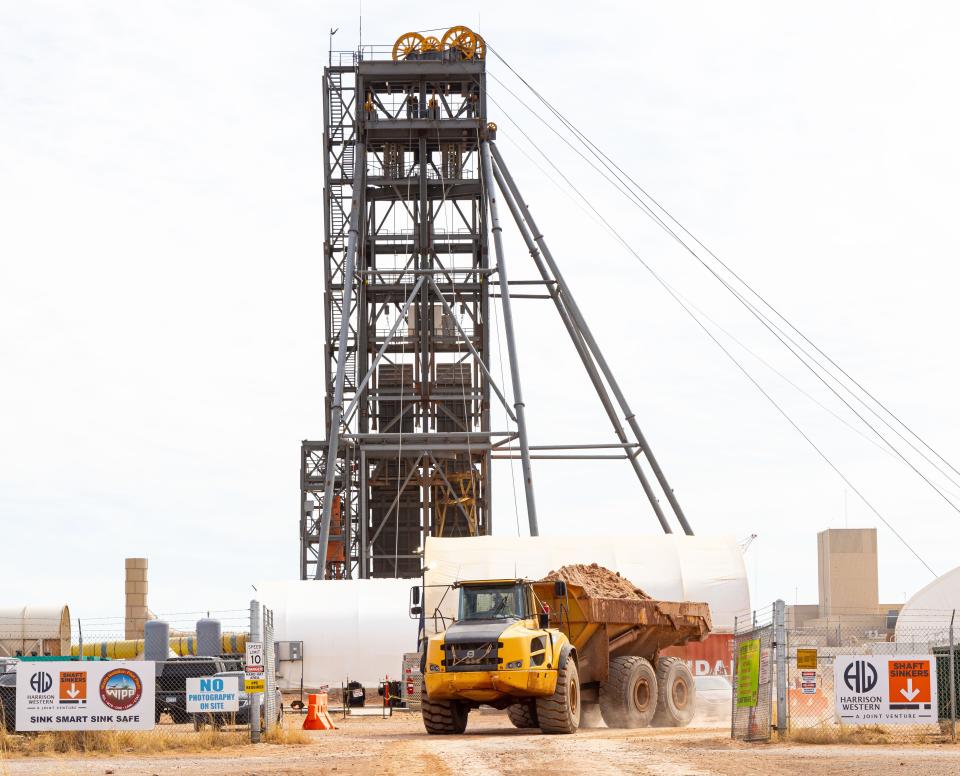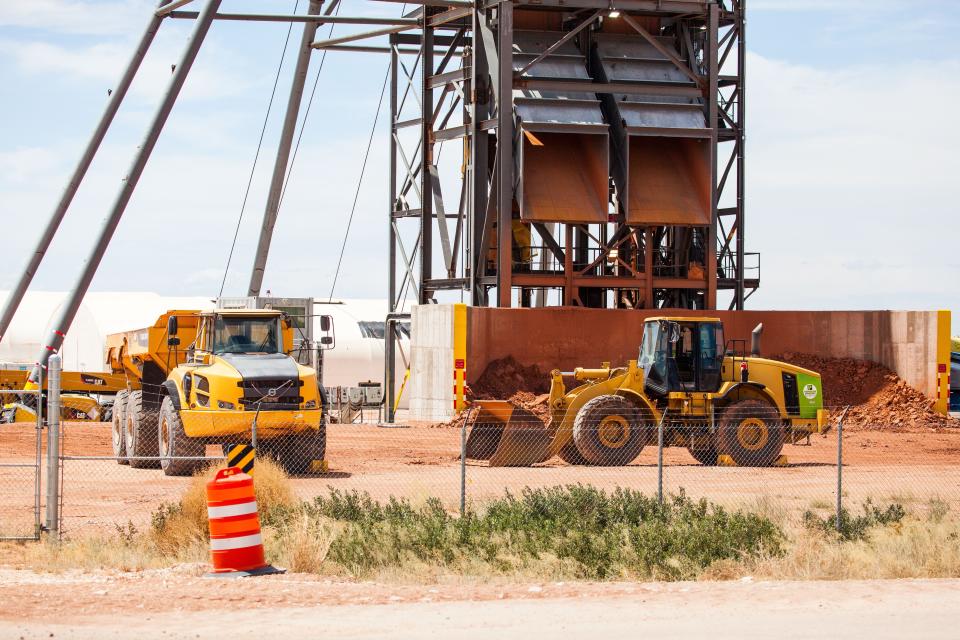'Partial work' resumes after cable snap shut down utility shaft project at WIPP
Nuclear waste officials said work on an air shaft at the repository near Carlsbad resumed last month after a cable snapped in the shaft and caused a basket to fall more than 2,000 feet to the bottom.
The shaft, the fifth at the Waste Isolation Pilot Plant, was under construction when the incident happened on Nov. 20, 2023 after the basket was skewed while being lifted toward the surface, colliding with steel framing at the hoist opening.
The $100 million project will serve as an air intake for a larger, $470 million rebuild of WIPP’s ventilation system intended to increase available air for workers to breathe in the underground.
More: Cable snaps inside utility shaft at WIPP, pausing work for now
When complete, the two projects will increase available air in the underground from about 170,000 cubic feet per minute (cfm) to 540,000 cfm.

It will also provide access to the west side of the mine, where transuranic nuclear waste from around the country is disposed of via burial.
“Partial work” on the shaft resumed Dec. 16, 2023, according to the Defense Nuclear Facilities Safety Board in its December report published Jan. 5.
More: Federal budget talks could endanger Holtec nuclear waste site near Carlsbad
That included efforts to repair the shaft and prepare for the resumption of full construction, the report read, after a plan by subcontractor Harrison Western Shaft Sinkers was approved by WIPP’s primary contractor Salado Isolation Mining Contractors (SIMCO).
The subcontractor maintained additional safety personnel amid the recovery efforts, read the report.
In the November report from the Board, published Dec. 1, 2023, the watchdog agency reported this was the third hoisting-related incident at the utility shaft in about a month, leading SIMCO to issue the stop work order.
More: Why did so much of WIPP's 479 nuclear waste shipments in 2023 come from Idaho?
“Although the formal investigation continues, project staff have preliminarily identified that HWSS staff failed to implement formal controls for hoisting and rigging activities, instead relying on informal operator actions which proved ineffective,” read the report.
It wasn’t the first delay of the utility shaft project, after the project began in 2019 but was halted in 2020 amid the COVID-19 pandemic and an outbreak of the virus at the WIPP site.
In July 2023, the shaft reached its planned full depth of 2,275 feet and work began to complete its electrical components and tie the shaft into the rest of the mine.
More: Nuke weapons waste disposal using Waste Isolation Pilot Plant to have 'negligible impact'
“The new utility shaft is a key component of the SSCVS that, when online, will enhance WIPP’s capability to deliver the nation and New Mexico’s cleanup mission,” said SIMCO President Ken Harrawood in a statement.

Problems also plague salt hoist used at nuclear waste site
Meanwhile, the board in the recent report noted several safety risks at WIPP’s salt hoist, an elevator used to bring mine salt out of the mine and to the surface.
“The Salt Handling Shaft continues to be the subject of ongoing federal and contractor evaluations regarding its structural condition and efforts required to maintain safety and operational capabilities,” read the report.
More: Cold War nuclear waste is prioritized at Carlsbad-area repository. How much is there?
Those concerns dated back to 2017, the report read, and while temporary repairs were made in the years since, problems lingered with the overall structural integrity of the 40-year-old hoist and funding for a “permanent resolution.”
As salt walls around the hoist deformed or “creeped” over the years since it was built, the load increased on the structural steel supporting the lower part of the shaft, the report read, causing parts of it to fail.
Steel bracing was installed to temporarily hold back the weight, but additional funding was needed to completely rebuild the frame, read the report.
More: Here's what New Mexico will get out of the $883 billion federal defense bill
Salt creep was also reducing the clearance between the conveyance cart that carries the salt up and the frame, potentially impeding the cart’s movement in the future, the report read, and putting it out of service.
WIPP officials were considering funding for a conveyer and apron feeder to load salt to the surface, which would act as an alternative to the hoist, read the report, while also voicing the need to maintain the hoists ability to move workers in and out as an alternative to the main elevator.
“Discussions with site shaft engineers highlighted a strong priority for them to maintain the ingress/egress function though partial structural modifications, even if the salt conveyance capabilities are lost,” read the report.
Adrian Hedden can be reached at 575-628-5516, achedden@currentargus.com or @AdrianHedden on the social media platform X.
This article originally appeared on Carlsbad Current-Argus: Utility shaft work resuming at WIPP. Concerns linger salt hoist

